
Wildlife Program report: Feb. 1-15, 2023
Managing Wildlife Populations
Elk Habitat: Natural Resource Technician Janowski submitted a grant proposal for review for a forest enhancement project in Stevens County.
Trespass Snowmobilers: Sherman Creek Wildlife Assistant Manager Palmer requested assistance from enforcement, concerning trespass snowmobiles and their potential for disturbing big game on Bisbee Mountain. Fish and Wildlife Officer Schrader encountered two snowmobilers at the bottom of Trout Lake Rd on Scotch Creek Wildlife Area on the weekend of Jan. 28 and Jan. 29. The two men claimed they didn’t see any signs, but knowingly went around the locked gate at the bottom of Trout Lake Road. Officer Schrader educated them and gave them a warning. Palmer and Combs, the managers of Sherman Creek Hatchery, were glad to find out that Schrader had caught them. They monitor the area as often as they can, but they haven’t caught anyone. Until now that is, thanks to Officer Schrader.

Lynx camera check: Wildlife Biologist Turnock, Wildlife Area Manager Palmer, and Wolf Biologist Roussin checked cameras deployed in the Kettles for lynx monitoring. Cameras were checked for correct viewshed, batteries replaced, and new SD cards installed. The photos will be sent to Washington State University for species detections and WDFW will use photos for the annual wolf report and for Wildlife Survey Data Management.
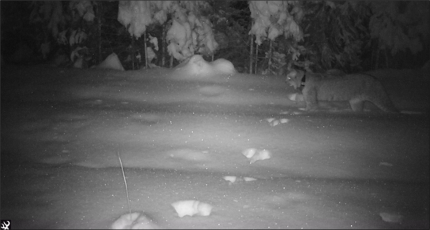
Elk: Assistant District Biologist Vekasy counted and classified multiple groups of elk in the Stateline area. Vekasy identified 314 elk with a calf to cow ratio of 25 calves to 100 cows. This segment of the Blue Mountains elk herd has been stable to growing in contrast to the rest of the Blue Mountains herd area.
District Biologist Wik met with the new district biologist for Oregon Department of Fish and Wildlife in Wallowa County. Discussions focused on elk surveys, elk movement, bighorn sheep movement, surveys, disease, capturing, and coordinating flights in areas of mutual overlap.
Chronic Wasting Disease Sample: Natural Resource Technician Barron submitted a Chronic Wasting Disease (CWD) sample collected from an elk harvested with a kill permit in Game Management Unit 121.
Natural Resource Technician Janowski collected two CWD samples from elk harvested using landowner kill permits in Stevens County.
Natural Resource Technician Heitstuman collected a CWD sample from a road killed deer. Heitstuman continues work regularly with landowners in the Cloverland area to prevent damage to crops by hazing elk. Some night work is being required to keep the elk from damaging the crops at night.
Providing Recreation Opportunities
Second Cougar Tag: Wildlife Conflict Specialist Kolb assisted a hunter who had questions about the availability of a second cougar tag for the Blue Mountain game management units. After speaking with local enforcement and licensing staff members in Olympia, Kolb passed the relevant information along to the hunter. Additional information about the hunt opportunity was shared with District 3 staff during the quarterly meeting.
Hunter Access: Biologist Baarstad completed a draft Feel Free to Hunt Contract for a private timber company in District 1 and sent it out for review. Baarstad was contacted by a turkey hunter from Alabama regarding District 1 spring turkey hunting opportunities and will be sending information out to him in the next few days.
Columbia Plateau Wildlife Management Association Landowner Hunting Permit Program: Private Lands Biologist Gaston coordinated more information between the WDFW customer service staff members and the Columbia Plateau Wildlife Management Association Landowner Hunting Permit organization. Hunters who were drawn for the Landowner Hunting Permit hunt now have access to purchase their permits.
Providing Conflict Prevention and Education
4-O Ranch Wildlife Area Haystack Moving: Wildlife Area Manager Dice discovered a haystack on the 4-O that was left outside of the fence surrounding the upper hayshed, had been discovered by elk a little over a week ago. The hay was left by WDFW’s agriculture lessee and was supposed to have been removed from the wildlife area last August. The elk, mostly mature bulls, were eating the hay and not leaving the area making them vulnerable. With the lessee, Dice and Natural Resource Technician Meisner moved a tractor to the 4-O along with a bale spear and grapple and moved the haystack. All the hay was cleaned up and the elk should move off to appropriate wintering areas where they will be safer.
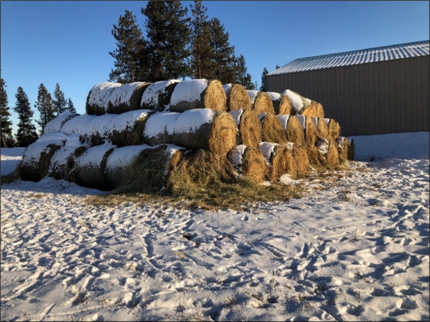
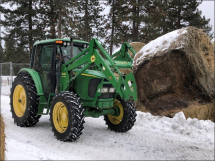
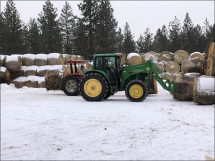
Elk Damage to Infrastructure: Hundreds of elk continue to move back and forth across the state line near Walla Walla. The constant road crossings have exposed buried fiber optic internet cable conduit in at least four separate areas within the state. Internet services in the area currently remain functional.
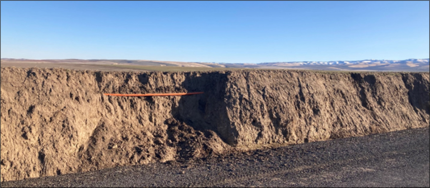
Wildlife Services Contact: Wildlife Conflict Specialist Wade was contacted by the United States Department of Agriculture Wildlife Services with a few questions regarding private landowners’ ability to remove coyotes with the use aircraft. Wade offered some information and provided him with contact information for WDFW enforcement officers in his area of operation. Wade also followed up with Officer Sabo regarding the questions.
Cattle Producer Contact: Wildlife Conflict Specialist Wade reached out to the Asotin County Cattlemen’s Association (ACCA) president to give him an update on current wolf activity and staff work. Wade also asked if ACCA president had any information or sighting to report.
Onion Creek Pack: Natural Resource Technicians Barron and Janowski and Wildlife Conflict Specialist Samsill deployed a radio activated guard box in a private pasture in the Onion Creek pack territory. Barron and Janowski loaned foxlights out to two landowners in the pack territory.
Conserving Natural Landscapes
4-O Ranch Wildlife Area Lands Check: Biologist Woodall and Natural Resource Technician Rimmelspacher traveled to the 4-O Ranch to check gates, ground conditions, and any sign of public use, and illegal motorized entry. They found little walk-in public use, no illegal snow mobile entry, gates were secured. There was deeper snow at the highest elevations, but the river breaks and lower benches were mostly snow-free with forage available for ungulates.
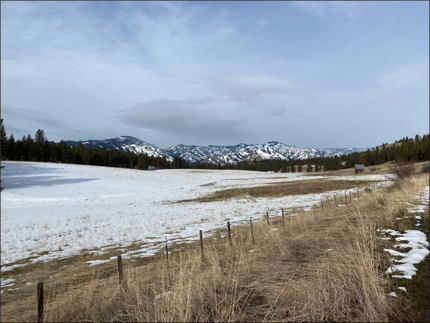
Forest Enhancement: Natural Resource Technician Janowski finalized and submitted a forest enhancement project proposal to WDFW’s ungulate specialist. If approved, the funding would go towards a tree planting project on a private property enrolled in Hunting Only by Written Permission.
McDonald Bridge Unit: Wildlife Area Manager Dingman and Access Technician Heimgartner took the dump trailer to the McDonald Bridge Unit and picked up the tires and litter that were cleaned up by the Whitman College volunteers over the weekend.
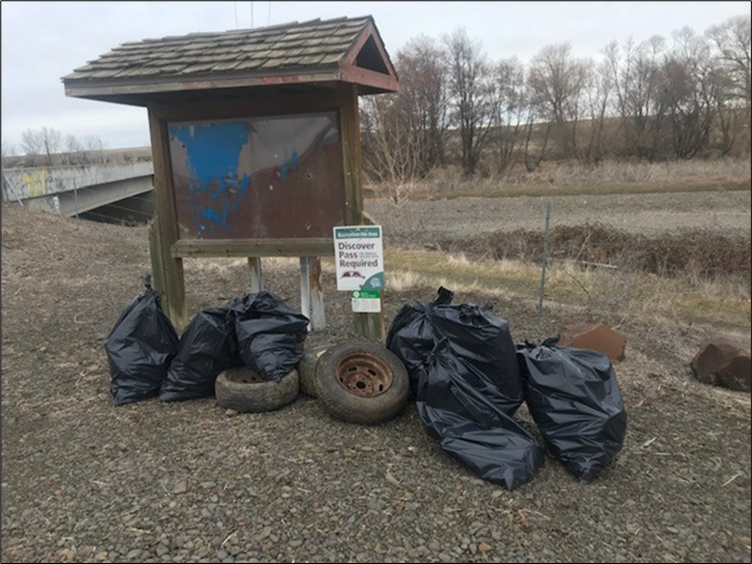
Conducting Business Operations and Policy
Regional Conservation Partnership Program: Private Lands Biologist Gaston worked with Palouse Conservation District (PCD) staff to review an inter-agency agreement regarding Regional Conservation Partnership Program (RCPP). The agreement will be finalized with PCD soon and then sent to WDFW for review and their signature to join and assist with RCPP opportunities in the Palouse.
Administrative Duties: After completion of the interview process, Wildlife Area Assistant Manager Finch has been selected as the new manager for Swanson Lakes Wildlife Area, its satellites, and the Revere and Reardan Audubon Wildlife Areas. He will also be responsible for the access areas in District 2, so will be supervising Access Manager Dziekan when Dziekan is working at District 2 sites. This hiring will complete the separation of the Sherman Creek Wildlife Area from Swanson Lakes Wildlife Area, which were complexed about fifteen years ago. Current Complex Manager Anderson will stay with Sherman Creek Wildlife Area. Finch has over 28 years of experience as the assistant manager at Swanson Lakes, is a lifelong resident of Lincoln County, and has farmed his family property there since the 1980s. Congratulations Mike!
Regional Conservation Partnership Program Meeting: Natural Resource Technician Nizer and Private Lands Biologist Gaston attended a meeting with PCD to talk about partnering with PCD and contributing our time and resources to the RCPP grant they received from the Federal Government. Through the meeting we discussed the projects that qualified as contributions and how to keep track of work done as well as how to input that into PCD’s submission portal on their website.
Wildlife Area Manager Finch finished installing the new front utility terrain vehicle (UTV) tracks on one of the Swanson Lakes Wildlife Area’s UTVs. The back tracks should be done soon. These tracks on the UTV will allow winter travel each year, over areas of Swanson Lakes that would otherwise be inaccessible due to heavy and drifted snow.
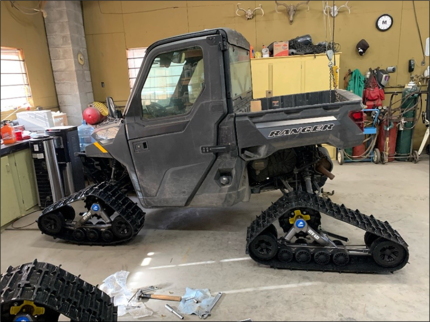
Other
Training: Private Lands Biologist Hadley participated in a Pollinator and Beneficial Insect Habitat Pertaining to Small Urban Farms and Community Spaces meeting offered by the Xerces Society.
Managing Wildlife Populations
Managing Pygmy Rabbit Recovery: Over the course of two days, Biologist Clements assisted with the pygmy rabbit team on their wild trapping efforts in the Beezley Hills. Several rabbits were trapped and vaccinated for Rabbit Hemorrhagic Disease (RHDV2), and there was a recapture of a female that was a translocation from Nevada back in 2020.
Pygmy Rabbit Burrow Surveys: The pygmy rabbit team has completed surveys for Beezley Hills, Rimrock Meadows, and Palisades. In Sagebrush Flats, the high occupancy areas have been searched. Now we will be focusing on exploratory areas where pygmy rabbits were historically and where they could have potentially moved.
Conservation Northwest Volunteers joined us for three days. In that short time, they found 73 burrows, collected 147 samples, and covered approximately 600 acres. University of Idaho students created a new record when they found 50 burrows in just one day. Our volunteers make a huge difference in helping us learn which rabbits are out on the landscape. This past month, we had partners from US Fish and Wildlife Service (USFWS), Bureau of Land Management, and Pheasants Forever also join us in the field.

In Sagebrush Flats, our largest question is where did the rabbits in the S3 enclosure go? Alarmingly, we could not find any evidence of them inside of the breeding enclosure. Genetic testing from the samples we collect in the surrounding area would confirm if these rabbits escaped. We are actively looking for carcasses to test for disease, but no carcasses have been located. There are however, a few suspicious holes in the fence.
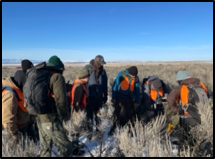
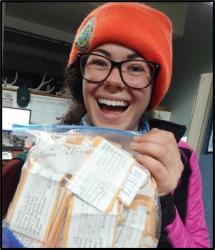
Wild Trapping: For the first time, the pygmy rabbit team began winter trapping efforts. Winter trapping is much easier than trapping in the spring, summer, and fall because the snow covers inactive burrows, tracks and signs are easier to detect, and pygmy rabbits are more likely to stay close to their burrows in winter conditions. Trapping was a complete success in Beezley Hills. We were able to trap and vaccinate ten new rabbits that we had not previously caught. Most notable was Rabbit NV2002. This rabbit was caught in 2020 in Nevada and translocated to Washington. It has not been redetected for the last three years, so we were very excited that it showed back up in our traps. All the rabbits were healthy and were returned safely to their burrows.
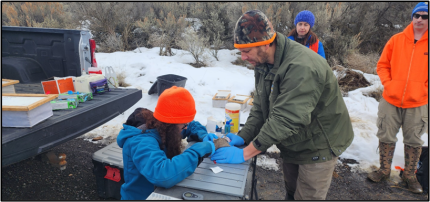
Welcome our New Staff Member: Our new Scientific Technician Kaley Meacham has arrived, all the way from Kansas. Kailey has a strong interest in studying genetic diversity and is gearing up for her master’s degree at the University of Oklahoma. She has experience working with various small mammals including pika, black-footed ferrets, and prairie dogs. Kailey brings lab knowledge, survey skills, and enthusiasm to our team. When she isn’t out looking for pygmy rabbits, she plans on backpacking and looking at birds.
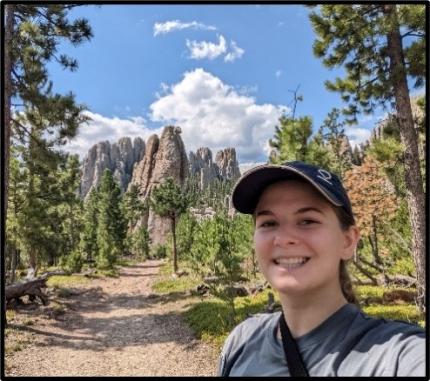
Mule Deer and Bighorn Sheep: WDFW contracted with Leading Edge Aviation to conduct helicopter captures, collect biological samples, and attach radio collars to mule deer and bighorn sheep in District 6 as part of a broader effort throughout central Washington in Klickitat, Yakima, Kittitas, Chelan, and Okanogan counties. In Okanogan County, they successfully captured and radio collared 17 mule deer in the Methow Valley, 51 mule deer in the Okanogan Valley, nine bighorn sheep in the Mount Hull herd, and seven bighorn sheep in the Sinlahekin herd. The goals of this effort are to better understand adult survivorship, migration, annual mortality rates, and cause-specific mortality. The collars have the added benefit of increasing the ability to detect bighorn sheep during surveys.
Bighorn Sheep: District 7 biologists Jeffreys and Eilers assisted District 8 with aerial bighorn sheep captures and GPS collar deployment in Yakima Canyon.
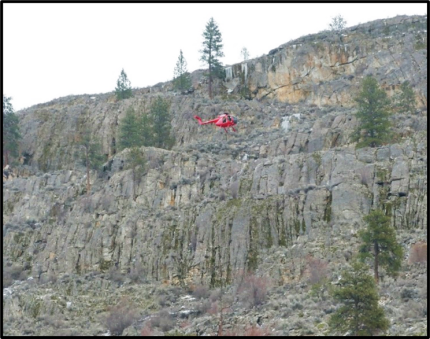
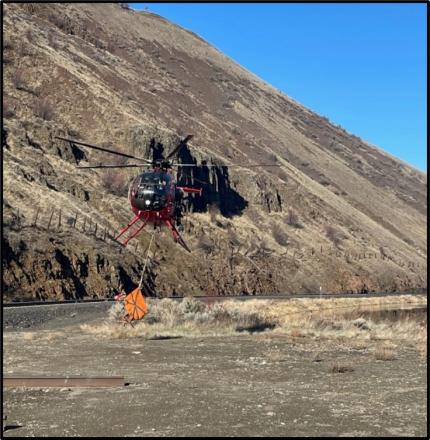
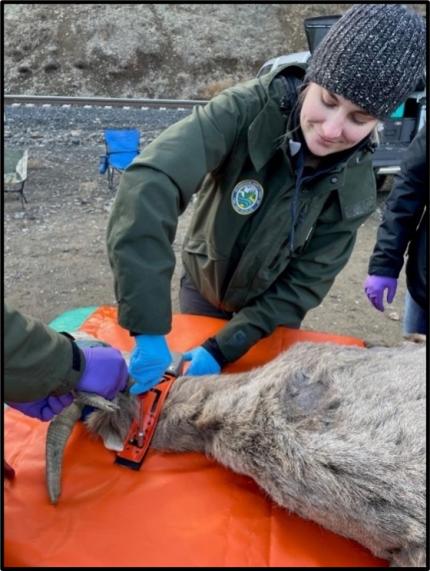
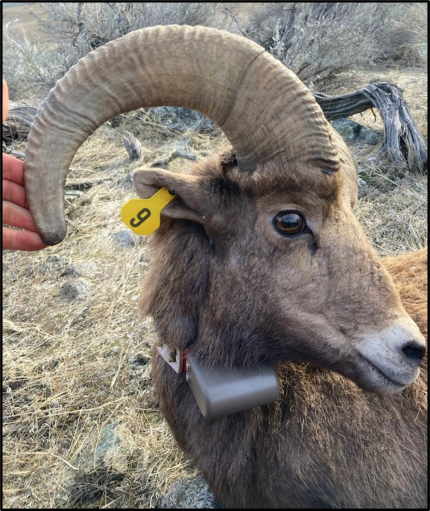
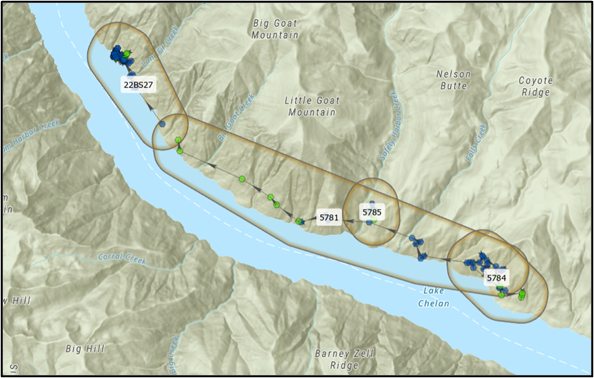
Bighorn sheep: In Chelan County, WDFW contracted Leading Edge Aviation to capture and deploy five new bighorn sheep GPS collars in the Manson herd. Biological samples such as blood, hair, and nasal swabs were collected from all captured animals to assess individual health and the presence of diseases or parasites. Then each animal was fitted with a GPS collar before being released onsite. Biologists will use the GPS collar data to track movements of individuals and learn more about herd home range sizes and distribution, migration routes and timing, and to aid in relocating animals for future abundance and composition surveys.
Mountain Goats: As the latest step in ongoing efforts to learn more about the declining mountain goat populations on both shores of Lake Chelan, District 7 planned on deploying 10-20 GPS collars within these herds in January. However, the intensive aerial capture efforts were cancelled and postponed until next winter season due to safety concerns. The recent rain on snow and warming temperatures experienced in the Lake Chelan Basin made the steep hillsides and cliffs too icy and dangerous to put capture crew personnel on the ground in most areas. The capture crew was able to selectively capture two mountain goats that were in safer terrain. They deployed GPS collars on one nanny on the south shore and one nanny on the north shore.
Biological samples such as blood, hair, ear and nasal swabs, and fecal pellets were collected from both goats to assess individual health and the presence of diseases or parasites before the collared nannies were released onsite. Biologists are very excited for next winter’s capture efforts as further data is needed to help assess potential reasons for the declining Lake Chelan mountain goat populations.
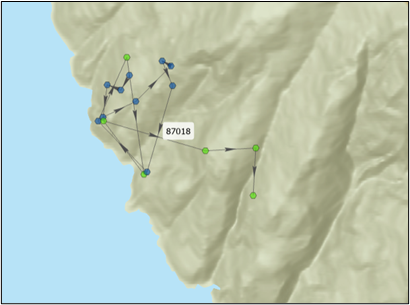
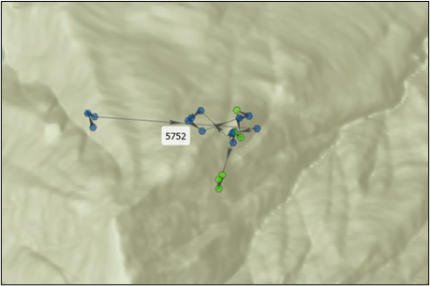

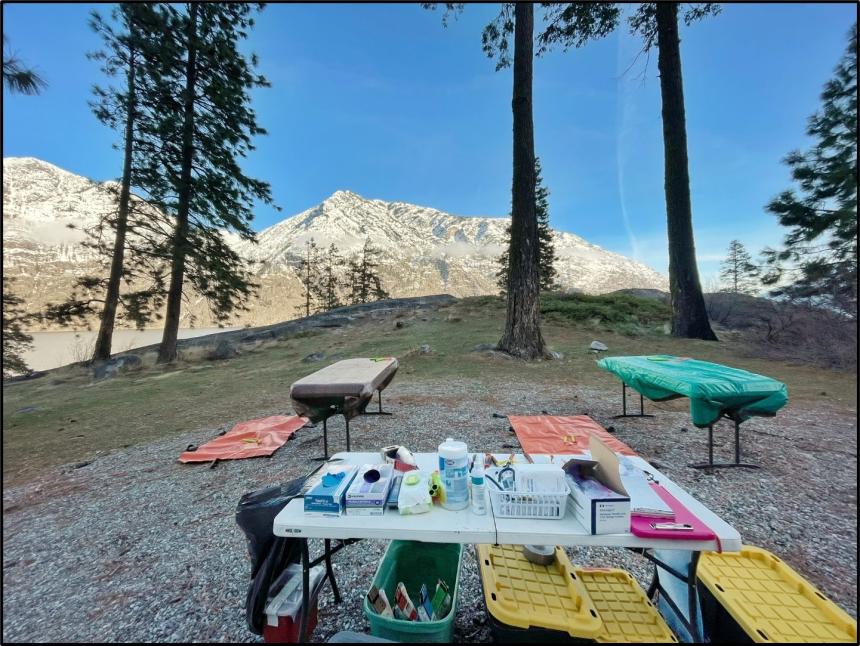
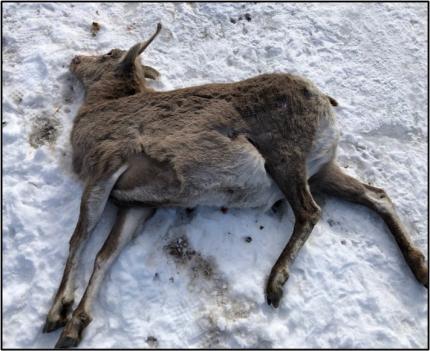
Mount Hull Bighorn Sheep: The Washington Department of Transportation contacted Biologist Heinlen informing him that a bighorn sheep ewe was struck and killed on State Highway 97 south of the town of Oroville. Biologist Heinlen inspected the carcass and collected samples specifically for disease and parasites.
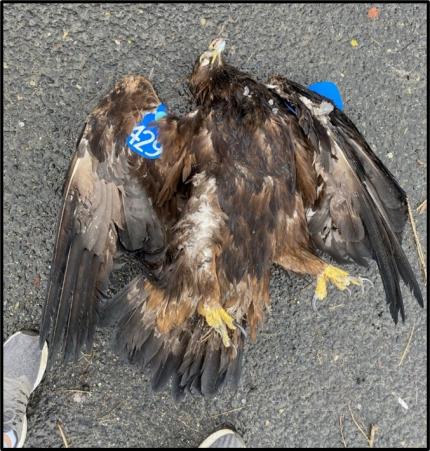
Trapped, Sick and Injured Wildlife: Earlier in January, Biologist Clements collected a deceased golden eagle that appeared to be hit by a vehicle on State Route 28. This golden eagle had patagial tags as well as a leg band. With the help of many individuals and entities, we were able to find out that this golden eagle was an adult female that was captured in Florence, Montana on Jan. 30, 2020.
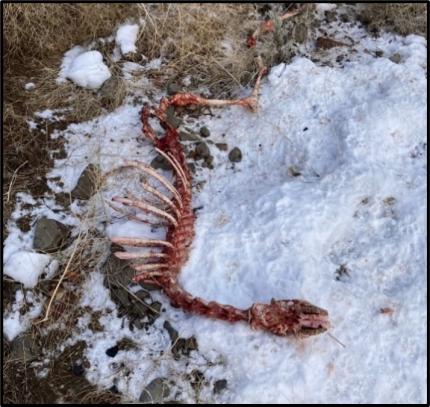
Mule Deer Mortality: Biologists Jeffreys and Eilers received a mortality signal from one of the District 7 GPS collared mule deer in the Wenatchee Mountains. Biologists went to the mortality site 48 hours after the signal was initially sent and found a completely scavenged carcass with only the skeleton remaining.
There were abundant coyote signs and tracks. Due to not having an intact carcass to perform a mortality investigation, the cause of death could not be determined. The GPS collar could not be found or retrieved due to a lack of signal. Biologists predict that the coyote family enjoyed a new chew toy from the leather strap of the GPS collar.
WDFW and Washington State University Meso-Predator Research Project: WDFW personnel assisted State Furbearer and Bear Specialist Lindsay Welfelt to set up camera traps for a WDFW and Washington State University research project. This project is designed to estimate the abundance of Canada lynx and bobcat in the Sinlahekin Wildlife Area and the nearby Loomis State Forest.
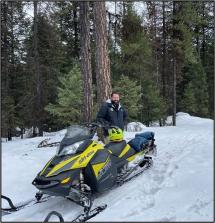
Mountain bluebird boxes: Sinlahekin staff members cleaned out 112 bird boxes utilized by species such as western bluebirds, tree swallows, and wren species on the Sinlahekin Wildlife Area.
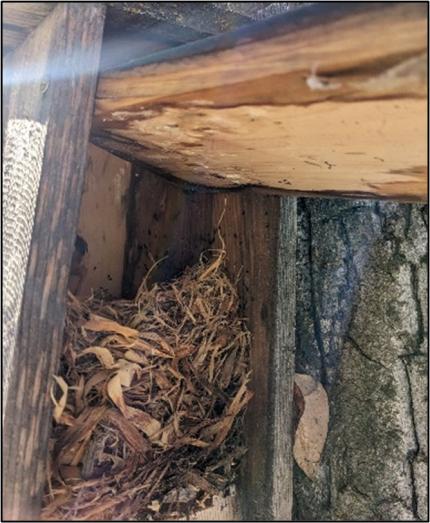
Scotch Creek Sharp-tailed Grouse: Staff members surveyed the riparian areas in Siwash and Tunk Valley for sharp-tail grouse. No grouse were observed during the survey. Both Siwash and Tunk have open south slopes, allowing the grouse to forage on the ground. Staff members constructed nine new top nets for the sharp-tail grouse traps. They also constructed ten new funnels for the sharp-tail grouse traps. The new funnel design was developed by Grouse Lead Atamian. The funnels are set up adjacent to the trap and guide the grouse into the trap.
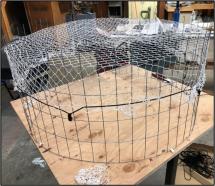
Ground Squirrels: District Biologists are gearing up for another year of Washington ground squirrel surveys, in addition to a translocation effort that will move an entire colony away from a site that will be developed this year. Many of the logistics still need to be worked out, but in coming weeks many of the outstanding questions will be addressed.
Northern Leopard Frogs: Biologist Grabowsky has been assisting with development of the next Competitive State Wildlife Grant grant proposal for the past few weeks. This involves coordination with internal and external partners, collation of northern leopard frog (NLF) reintroduction and management ideas, and research into how those idea can be incorporated and implemented into the current recovery for this species. Technician Haines completed habitat assessments at several potential NLF reintroduction sites. These assessments will help us determine sites that could support NLF in the future and management activities that need to be completed before frogs are translocated to the site. Technician Haines has also been fine-tuning and testing methods for using the I3 Pattern software to identify individual NLF by spotting pattern. This software has been successfully used to identify herps and shows promise with NLF since each frog has a unique spotting pattern. Once these methods are refined and approved by the Science Division, the hope is that WDFW can implement this technique into future monitoring work.
Biologist Grabowsky completed the recruitment paperwork to hire another seasonal technician to advance NLF recovery this year. The anticipated start date for this position will be sometime in March or early April.
Waterfowl: Biologist Clements conducted swan surveys on Jan. 19 with the assistance of Technician Haines. They focused on areas that have had swan sightings reported over the winter and a total of 71 swans were counted that day. Of the 71 swans recorded, 51 of them were positively identified as trumpeter swans, and the remaining 20 were unknown. Since the survey day, many more sightings have been reported via email to biologist Clements. She will be adding those sightings into a spreadsheet to assist with future monitoring. Thank you to everyone who has passed along reports of swans in the local area!
Providing Recreation Opportunities
Providing Education and Outreach: Biologist Clements attended the Washington Waterfowl Association (WWA) meeting for the Moses Lake chapter on Jan. 19, 2023 to provide an update to the chapter with final banding numbers for the 2022 banding season as well as recruit volunteer help for the upcoming season. There was a good amount of interest within the group for banding help this 2023 season, and WWA members have been extremely helpful with keeping an eye out for swans as well.
Mule Deer Feeding: Biologist Fitkin and other WDFW staff members addressed concerns over the potential need to emergency feed deer in the Methow Valley by working with the Methow Valley News on a prominent article on the subject explaining why feeding is generally a counter-productive management option.
Boating Facilities Program Grants: Okanogan Lands Operations Manager Haug worked on several boating facilities program related tasks. Haug met with the Wolf Creek Irrigation District Board and members to discuss concerns regarding the fully funded Patterson Lake improvement project. Overall, the board and members seemed supportive but delays in construction are still ongoing as a title report is being generated. Haug also submitted final applications and presented two new projects for Sidley and Spectacle Lake. Those projects would bring much needed improvements to those access areas. He met with both county commissioners and the community of Molson to present the Sidley Lake project with overall positive feedback.
Hunter Access: Biologist Cook continued to check Hunter Access signs and map sign locations. This mapping effort is to better notice areas where signs are knocked off or lost due to winds or farm equipment and to find areas where signs are repeatedly removed. This tracking will improve the ability for consistency of signing each year. As part of checking Hunter Access signs, Cook replaced two signs on one property where signs are intentionally being removed. Biologist Morris scouted for agricultural fields being used by waterfowl as a potential opportunity to obtain hunter access in the future.
Providing Conflict Prevention and Education
Elk Damaging Haystacks: Specialist Heilhecker visited with a landowner regarding elk damage to his haystacks. The landowner had an active landowner damage prevention cooperative agreement. Specialist Heilhecker issued the landowner a kill permit to remove one antlerless elk. They also discussed fencing the haystack as part of a cost-share fencing agreement with WDFW.
Turkey Trouble: Specialist Heilhecker met with a landowner regarding turkeys getting into cattle feed. The landowner signed a landowner damage prevention cooperative agreement. Previously turkeys had been getting into his haystack, and tarps provided by WDFW stopped the haystack damage. Yet, the turkeys have not left the area and are now getting into feed left out for the cattle. Specialist Heilhecker issued several turkey permits to the landowner.
Responding to Wolf Reports: Specialist Heilhecker received two wolf sightings reports. There was one unconfirmed report of wolves howling west of an RV park north of Twisp. An approximate location would place the wolves on Department of Natural Resource or WDFW land. The second report was a confirmed sighting of one wolf, with possibly a second wolf, on Pogue Mountain. The reporting party submitted photos of tracks. Both reports were entered into Spillman.
Providing Conflict Prevention: Biologists Dougherty and Clements completed the firearms training to assist with wildlife conflict staff in the future. This training took place on Jan. 17 and Jan. 18, 2023, and they have both received their certifications in the mail.
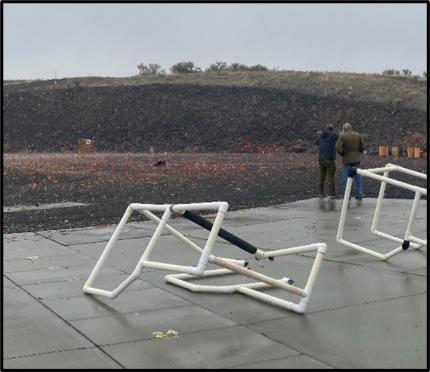
Douglas County State Acres for Wildlife Enhancement Conservation Reserve Program Update: To date, Private Lands Biologist Braaten has received 58 State Acres for Wildlife Enhancement Conservation (SAFE) contracts from Douglas County Natural Resources Conservation Service (NRCS) and Farm Service Agency (FSA) offices. Fifty-eight contracts containing 8,825 acres on over 130 fields have been received. The signup is ongoing and more SAFE contracts may be accepted by FSA. General Conservation Reserve Program (CRP) signup is due to begin in February. FSA has not provided the contracts that were signed up for fiscal year 2022. We have asked several times and no answer has been provided. Information is provided to landowners as it becomes available from FSA and NRCS.
SAFE-CRP: Biologist Cook spoke with a SAFE-CRP landowner in Adams County specifically about work vital for field preparation needed this spring on a newly enrolled field.
Scotch Creek Riparian Enhancement: Staff members ordered 200 water birch plugs to be planted in the project area fall of 2023 prior to snow fall. Water birch provides an important food source for sharp-tail grouse when snow creates a barrier to native grass and forb seeds.
Conserving Natural Landscapes
Scotch Creek Riparian Enhancement: WDFW personnel ordered 200 water birch plugs to be planted in the project area fall of 2023 prior to snow fall. Water birch provides an important food source for sharp-tail grouse when snow creates a barrier to native grass and forb seeds.
Providing Education and Outreach
Sinlahekin Spring STEAM in the Field Event: Lands Ops Manager Haug met with Sinlahekin Wildlife Area Manager Wehmeyer, Assistant Manager Riley and North Central Educational Service District (NCESD) Regional Science Coordinator Haug to discuss a potential Science, Technology, Engineering, Arts & Math (STEAM) in the field event for two fifth-grade classes this spring. The group talked about logistics, station subjects, and overarching themes students can learn and take away from the event. Planning has just started, and the event is roughly scheduled for late April.
Conservation Easement Management: Lands Operations Manager Haug has been working with a large landowner in Methow near Twisp where WDFW holds a conservation easement. The two have been in discussion on a potential conservation plan for the property and how that plan compliments the easement language. Haug will be meeting with the landowner, Department of Natural Resources, and NRCS staff to discuss the potential partnership and determine how best to fund the planning effort.
Conducting Business Operations and Policy
Meetings: Biologists Cook and Morris attended a meeting of the Moses Lake chapter of Washington Waterfowl Association to discuss field hunting opportunities for geese. Cook presented an overview of past efforts to provide field hunting opportunities and current efforts under a new program, Waterfowl Habitat and Access Program. Cook also answered questions about the Hunt by Reservation system and Register to Hunt which will be used for these sites. Biologists Cook and Morris requested input, to get the hunters’ perspective and on desirable locations for these field hunting opportunities. This input will guide efforts to secure Hunter Access properties for this program.
Acquisitions and Easements: Private Lands Biologist Braaten worked with district and regional staff on several properties that are under consideration for acquisition and/or easements. A possible opportunity in the Carlton area was evaluated with input from staff members and forwarded to help determine if WDFW is interested. Another opportunity is a property in Douglas County which has sharp-tailed grouse, where a family has decided to sell. Initial discussions and information exchange has begun with local and regional staff members. Private Lands Biologist Braaten provided suggestions of possible approaches with specific landowners.
Methow Winter Management: Assistant Manager Repp worked on and completed the annual weed survey for 2022. He submitted documents related to a statewide Public Disclosure Request (PDR) on herbicide use. Manager Troyer and assistant manager Repp attended a day long workshop on cultural resource related topics. Assistant manager Repp worked across program lines to help extricate enforcement vehicles stuck in the snow near Beaver Creek Campground.
Scotch Creek Winter Maintenance: Staff members continued doing maintenance and repairs on vehicles, all-terrain vehicles (ATV), and farm equipment. They also upgraded three light fixtures in the office to LED. Additionally, staff members ordered and picked up lumber from a local vendor. The 2x6s will be used to replace degraded deck boards at the office.
Sinlahekin Winter Maintenance: Staff members conducted preventative maintenance on four ATVs and two utility task vehicles. Additionally, they repaired decking on a trailer. Staff members also created several spray-tank brackets for ATVs and installed spray-tanks. Staff members also repaired wooden fencing surrounding an ephemeral spring near Hahn’s meadow on the Sinlahekin Wildlife Area.
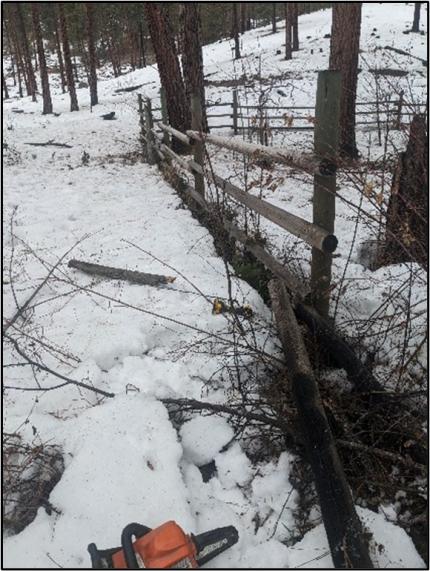
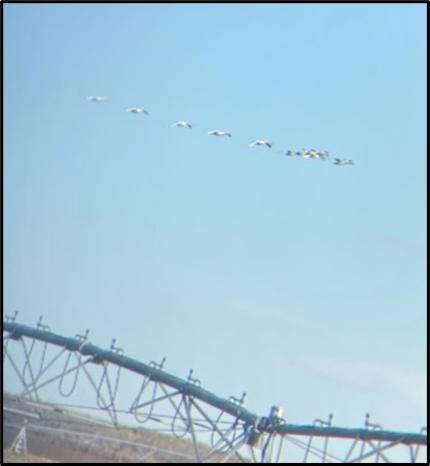
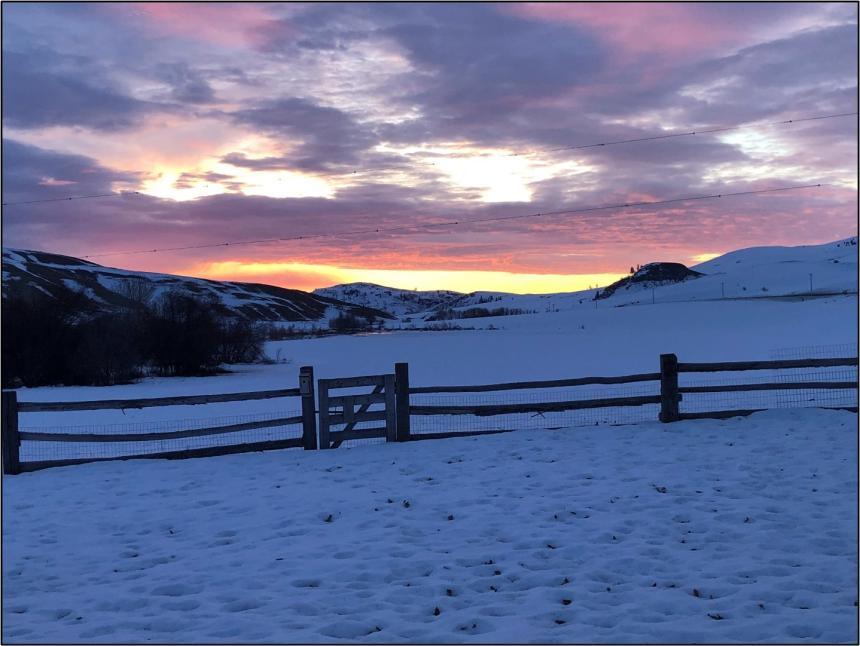
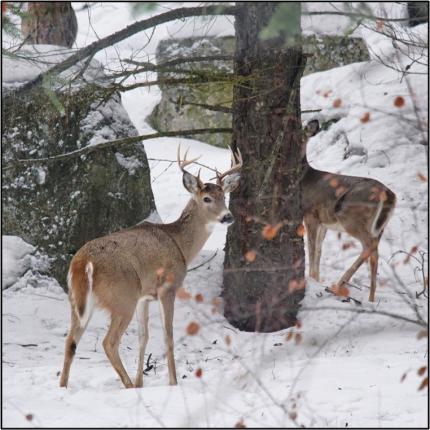
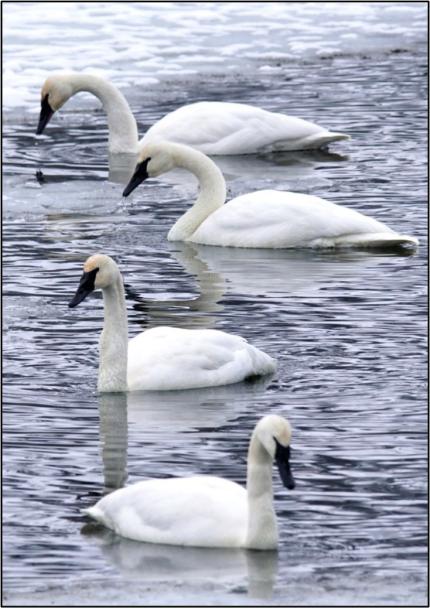
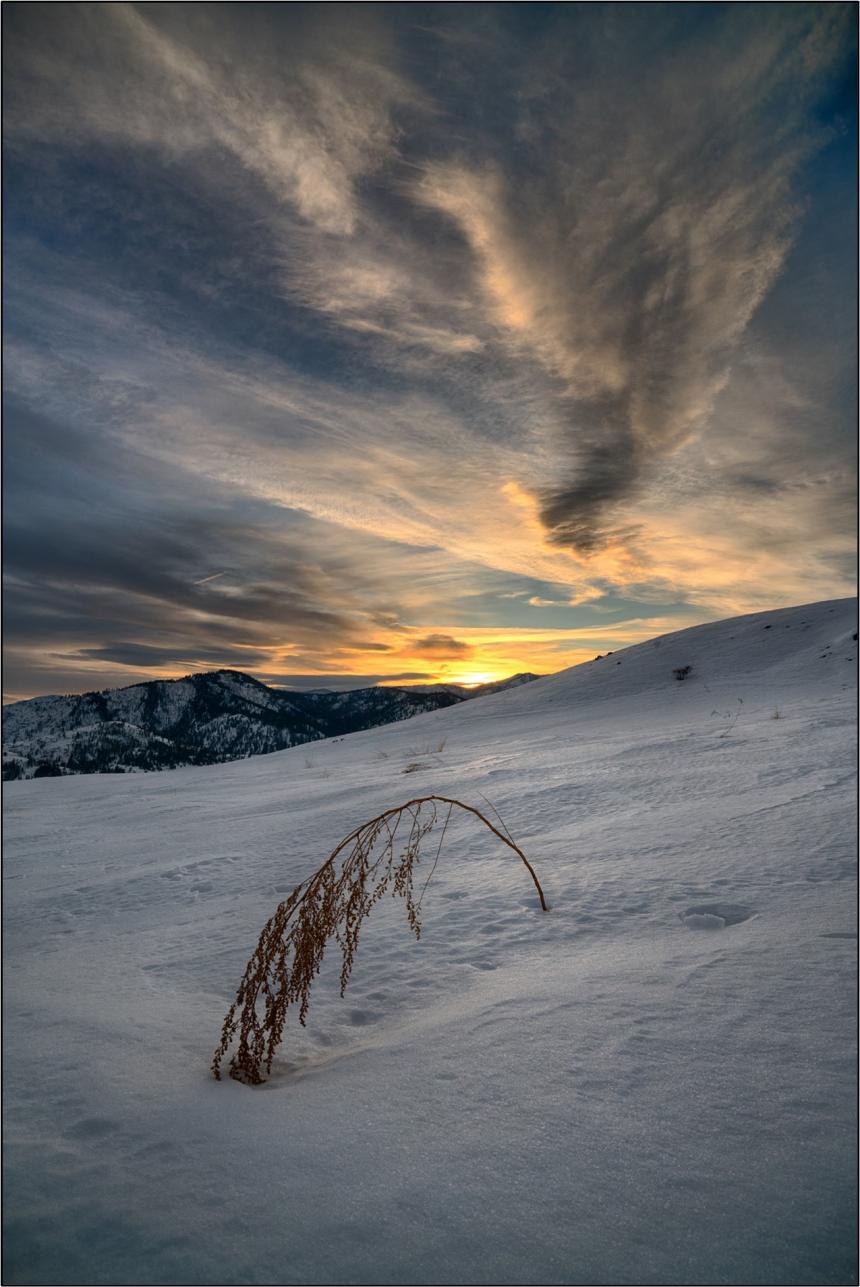
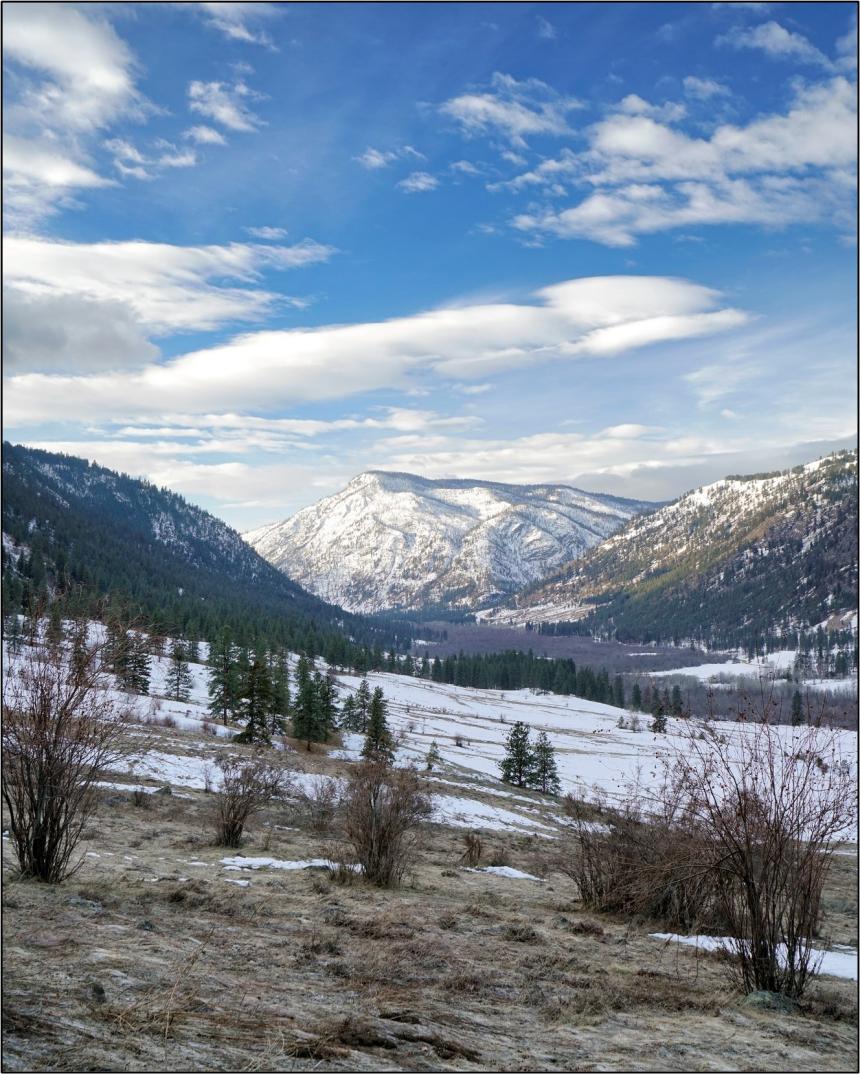
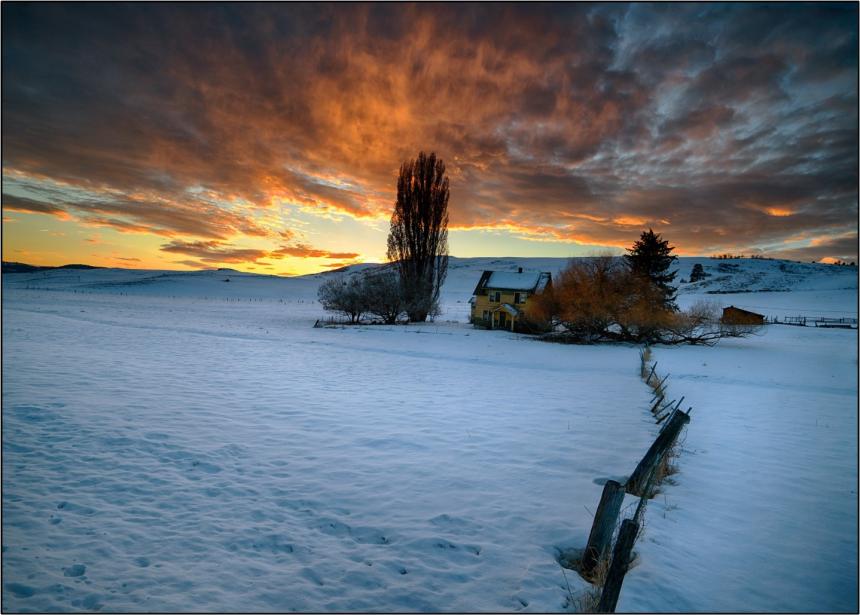
Managing Wildlife Populations
Bighorn Sheep Mycoplasma Ovipneumoniae Testing: Results of disease testing from bighorn sheep captures in the Yakima and Cleman herd earlier this year found no confirmed cases of Mycoplasma Ovipneumoniae (MOVI) in tested individuals.
Herd Surveys: District 8 staff began conducting aerial population surveys of the Cleman Mountain and Quilomene Bighorn Sheep populations and the Yakima elk herd. Populations are surveyed from a helicopter and district staff members count and classify observed animals. For elk, group sizes can vary from one to over a thousand animals. When large group sizes are found, an aerial photograph is taken, and counts are conducted from image files using digital processing tools.
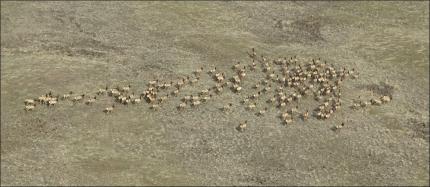
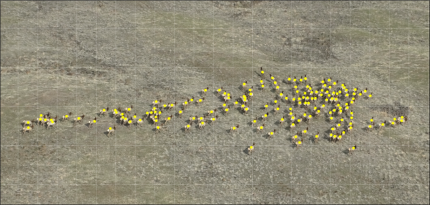
Bat Box Installation: District 8 wildlife staff members met with county representatives to determine locations of bat box installations designed to host maternity roosts in a newly planned flood plain restoration area along the Yakima River in Ellensburg.
Sunnyside Agricultural Field Monitoring: Waterfowl Specialist Wilson and Biologist Bernatowicz took down monitoring cameras and walked the agricultural fields in the Snipes Reserve looking for signs of waterfowl use outside the view of the cameras. Few pictures of waterfowl were seen during monitoring and no sign of significant use was found on the ground.
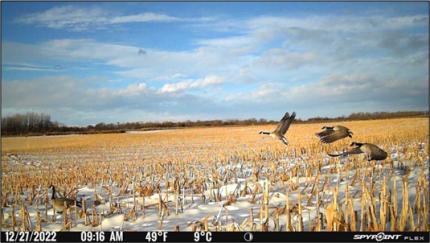
Pre-season Bluebird Box Checks: District 4 Wildlife Biologist Fidorra worked with volunteers to check bluebird nest boxes installed last year. Two nests were found from last season, one with shell fragments. The species identify of the nest hasn’t been determined yet, but it was not bluebirds and may be house sparrow.
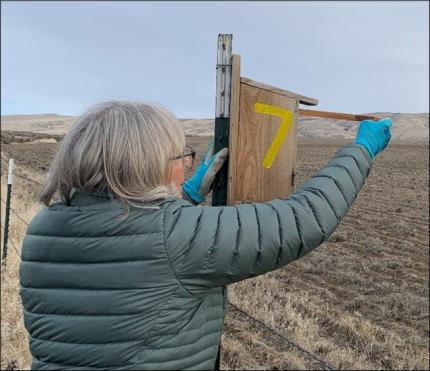
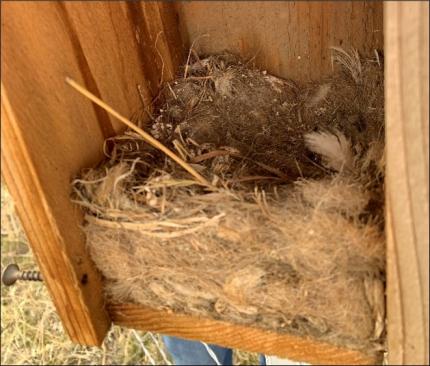
Burrowing Owl Artificial Burrow Maintenance Begins: District 4 Wildlife Biologist Fidorra coordinated a few volunteers and began maintaining artificial burrows prior to the breeding season. Several burrows had vegetation from wintering skunks or needed part replacements. Two burrowing owls were seen at the six sites visited this period and likely overwintered.
Winter Audubon Climate Watch Survey: District 4 Wildlife Biologist Fidorra spent a morning conducting point counts as part of a long-term Audubon Partner’s project related to climate change monitoring.
Elk Feeding: Elk numbers are back up after a brief respite following some warm weather and snow melt. The access road into the Robinson feed site has been pure ice for the last two weeks, making it necessary to continue feeding on the lower road. This makes accurate counting nearly impossible, but numbers are back up this week there as well.
| Date | Site | Cow/Calf | Branched Bull | Spike Bull | Mortality | Total |
|---|---|---|---|---|---|---|
| Feb. 13, 2023 | Watt | 767 | 11 | 14 | 0 | 792 |
| Feb. 13, 2023 | Robinson | 425 est. | 15 | 4 |
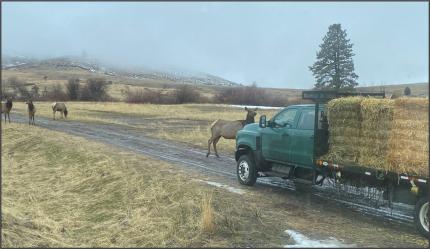
Wet Moldy Hay Fire Hazard: Several smoldering bales were discovered in one of the haystacks due to a hole in the tarp and continued water seepage. The combination of wet moldy hay and tarps trapping heat nearly caused instantaneous combustion. The bales were removed, opened, and spread out away from the barn and haystacks. Re-tarping leftover hay every year may help prevent this happening in the future.
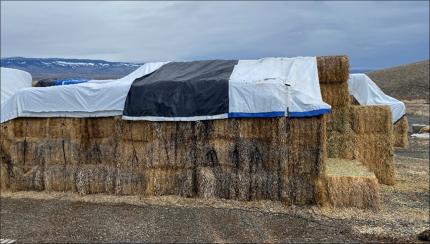
Sunnyside Unit Maintenance: Assistant Manager Ferguson and Natural Resource Technician Wascisin have taken advantage of the warmer weather recently to do some maintenance on the Sunnyside Unit including clearing cattails from the intake of the Giffin Lake pump and resurfacing the entrance road to the office and road to the Rice Paddies Wetlands.
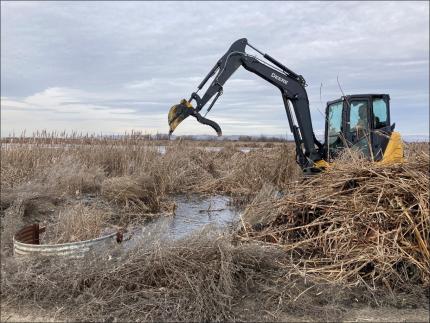
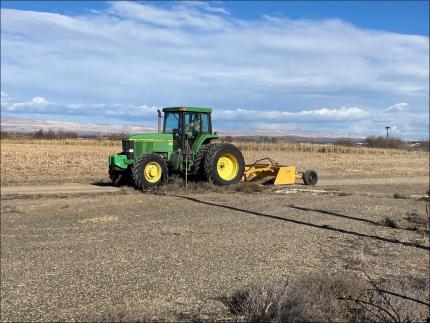
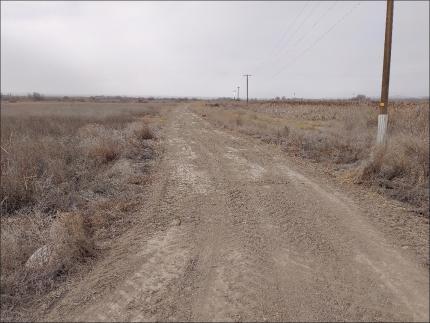
Providing Recreation Opportunities
Manastash Ridge Trails Plan Implementation: Recreation Specialist Frame designed new signage for the Manastash Ridge Trails area. These signs will help inform users of wildlife area rules and regulations and provide trail etiquette and trail safety tips. Other signage will include a trails conditions sign, interpretive wildlife sign, and trail descriptions. Plans to post the new signage will begin in the spring of 2023. Members of the Manastash Ridge Trails Committee were heavily involved in the message displayed on the signs.
Wenas Target Shooting Clean Up: Recreation Specialist Frame removed three pickup loads of trash from multiple spots within the wildlife area, including Sheep Company designated target shooting area, Sheep Company road, and Roza road. These areas have seen an increase in trash burning and trash dumping. Habitat Specialist Miller also assisted in the cleanup.
Providing Conflict Prevention and Education
Ice Harbor Deer: District 4 Wildlife Conflict Specialist Hand met with a manager of a large orchard, vineyard, and blueberry farm near the Snake River that is currently experiencing deer damage to several new plantings of trees. Non-lethal hazing had been implemented with diminishing results. A Damage Prevention Cooperative Agreement and associated damage permits were developed as well as deployment of youth hunters off the Region 3 special hunt permit roster to assist in their hazing efforts.
Paterson Area Deer: Wildlife Conflict Specialist Hand patrolled areas of south Benton County near the Columbia River that have historically received deer damage to mostly wine grape operations and orchards. Although some deer activity was observed, damage was very minor at this time. As warmer temperatures develop and plants come out of dormancy, deer activity and damage will become more prevalent.
Rattlesnake Hills Elk: Wildlife Conflict Specialist Hand continued to monitor for elk activity on the Hanford National Monument and adjoining private lands. Large numbers of elk continue to occupy low elevation areas near Highway 240 on the Hanford Monument.
Youth Damage Hunt Opportunities: Conflict Specialist Hand deployed youth from the Region 3 special permit roster to three landowners experiencing deer damage in their orchards and wheat crops in Game Management Unit (GMU) 381.
New Damage Permit System: Wildlife Conflict Specialist Hand began testing the new damage permit issuance and harvest reporting system being developed by WDFW Information Technology personnel. Several hurdles in accessing the system as well as navigation through the permit development process were experienced. Problem issues were documented, and testing of the system is continuing.
Hanford Elk Crop Damage Report: Wildlife Conflict Specialist Hand completed the required field report on a 2022 crop damage claim report from elk on winter wheat in the Rattlesnake Hills area.
Kahlotus Deer: Wildlife Conflict Specialist Hand continues to work with landowners in the Kahlotus area to minimize deer damage impacts to wheat crops in GMU 381. ATVs are being used to access difficult areas of crop fields to conduct hazing efforts. Large numbers of deer continue to be observed and moved out of crop areas.
Finley Sick Skunks: Wildlife Conflict Specialist Hand responded to a call concerning skunks in Finley that were acting strange. The caller reported that the skunks were walking in circles and had lunged at humans. Four skunks were killed and removed by the landowner, and one was collected for disease sampling.
Conserving Natural Landscapes
Restoration Work: Assistant Manager Winegeart used an over the shoulder hand crank to seed two temporary water trough sites in the Vantage pasture. The area will be harrowed and monitored for weeds. Natural Resource Technician Blore checked the condition of Cayuse restoration area.
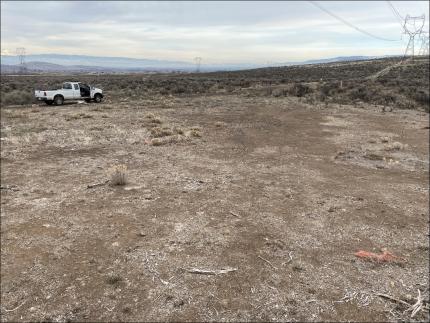
Vantage Rocky Mountain Elk Foundation Grant Proposal: Assistant Manager Winegeart completed and submitted a Rocky Mountain Elk Foundation wildfire grant proposal for the Vantage Highway Fire area. If funded, the grant will allow for aerial weed control across 1,000 acres, and aerial seeding on 200 of those acres.
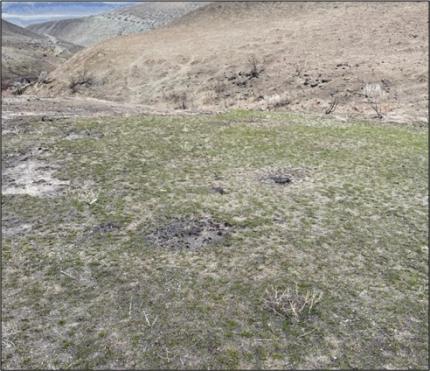
Whiskey Jim Pasture Fence Repair: Natural Resource Workers Hamlin and Schneider repaired pasture and exclosure fence in Whiskey Jim pasture. New barbed wire was added to a previously non-functioning section of fence between Whiskey Jim pasture and Upper Parke pasture.
Habitat Plantings on Private Lands Hunting Opportunities: Region 3 Private Lands Biologist Hulett, Private Lands Technician Manderbach, and Pheasant Forever Farm Bill Biologist Hennings installed 400 sagebrush and bitterbrush plants on two properties enrolled in the Private Land Access Program. Each shrub planting was also flagged for the upcoming herbicide treatments.
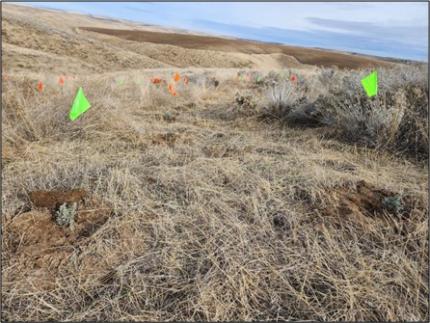
Habitat Planting at Thorton Unit: Sunnyside-Snake River Wildlife Area staff members borrowed a ten foot no-till Great Plains drill seeder from the South Yakima Conservation District for a wildlife food plot project in the Thornton Unit. The site was mowed, harrowed, and sprayed prior to seeding. The food plot mix containing don falcata alfalfa, delar small burnet, yellow sweet clover, appar blue flax, and Eagle western yarrow will provide forage for native wildlife populations including elk, mule deer, various upland birds, and pollinator species. The food plot is located within a Conservation Reserve Program section of the unit and will enhance forage availability for wildlife throughout the year. The seeder was a very efficient tool for this project. Private Lands Biologist Seth Hulett was very helpful with his instruction on calibrating and operating the seeder.
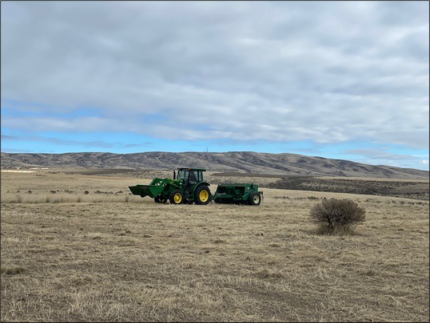
Bryon Unit Trash Removal: Assistant Manager Ferguson and Natural Resource Technician Wascisin removed a pile of several mattresses and couches that were dumped at the Byron Unit earlier this winter. The excavator worked out to be a great trash compactor for the items.
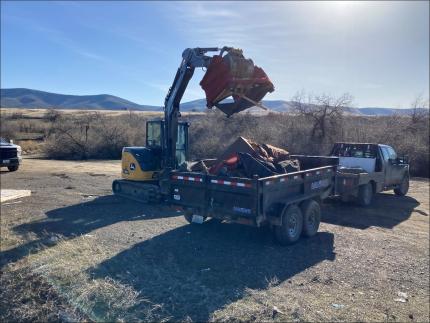
Providing Education and Outreach
Ferruginous Hawk Outreach Presentation: District 4 Wildlife Biologist Fidorra presented to an audience of over 80 people at the Washington Ornithologists Society this month. The presentation covered Department of Ecology and some WDFW science results from movement studies and addressed the surmounting threats and declining population of ferruginous hawks. It was well received and publicly available on the Washington Ornithologists Society’s YouTube channel.
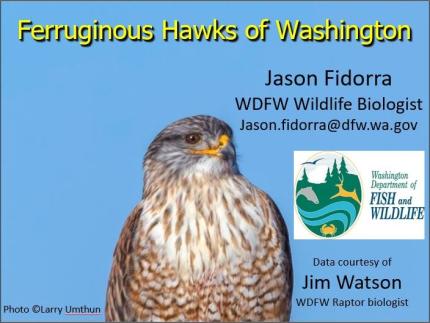
Birds & Blooms Magazine Spotlights the Black-chinned Hummingbird: Wildlife Biologist Fidorra responded to an agency interview request on black-chinned hummingbirds for the nationally distributed magazine. Fidorra provided information on range, identification, and basic ecology of the species for an upcoming article.
Pronghorn Report Draft Complete: Wildlife Biologist Fidorra worked with District 9 staff members to draft the 2023 survey report for the south-central Washington Pronghorn survey. The draft is circulating through Yakama Nation partners before being finalized and published on the WDFW website.
Bateman Island Causeway Recreation Meeting: Region 3 personnel met with concerned members of some of the recreation interest groups at Bateman Island to discuss their concerns related to breaching the causeway and future access to the island. Overall, the groups support the restoration goals of the project but want recreational access to the well-used public space maintained.
Recreation, Facility and Management Panel: Manager Hughes attended an education panel for members of the public developed from the Kittitas County Chamber of Commerce. Guest speakers from WDFW, Washington State Parks and the Bureau of Land Management each presented information about the mission of their agencies, local projects being conducted, and what their job consist of. Hughes did an overview of the Wenas Wildlife Area touching base on future shooting range development, trail management, habitat projects focused on forest thinning, and plans to seed historic agricultural fields back into shrubsteppe habitat in the fall of 2023.
Presenting to Landowners: Region 3 Private Lands Biologist Hulett presented at the Benton County Wheat Growers meeting highlighting the Private Lands Access Program to landowners.
Conducting Business Operations and Policy
Wenas Contract Management: Habitat Specialist Miller has started to review the new Bonneville Power Administration (BPA) contract. This starts the process of ensuring that the proper documentation is submitted to fulfill statements of work outlined in the contract. A large portion of the operating and maintenance budget for the Wenas Wildlife Area is funded by the BPA.
Managing Wildlife Populations
Bat Hibernacula Surveys: Biologist Wickhem assisted Technician Leipold with bat hibernacula surveys in the Gifford Pinchot National Forest for two days this month. US Forest Service Technician Motiff and Volunteer Petrie also assisted in the effort. Together, the teams skied and snowshoed several miles and surveyed five caves where they counted and identified species of bats roosting in each cave. Two other caves were located but not surveyed because of access issues. When bats from the genus myotis were found and within reach, the bats were directly swabbed to test for the fungus that causes white-nose syndrome. These surveys are part of a larger effort to survey a portion of over 600 caves within the Gifford Pinchot National Forest to see which support hibernating bats, especially Townsend’s big-eared bats which are a Washington Species of Greatest Conservation Need (SCGN) and a Priority Species under WDFW’s Priority Habitats and Species Program. In Biologist Wickhem’s two days on the survey, she recorded 157 Townsend’s big-eared bats, one myotis and got to explore some amazing caves.

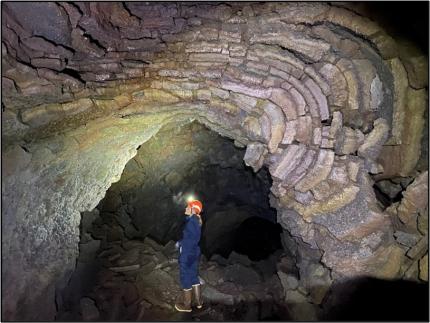
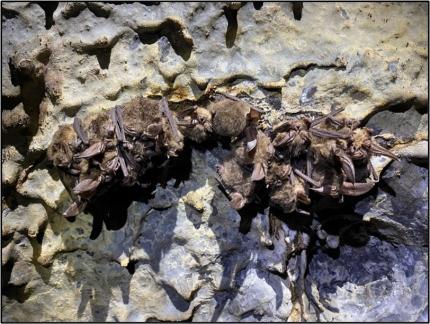
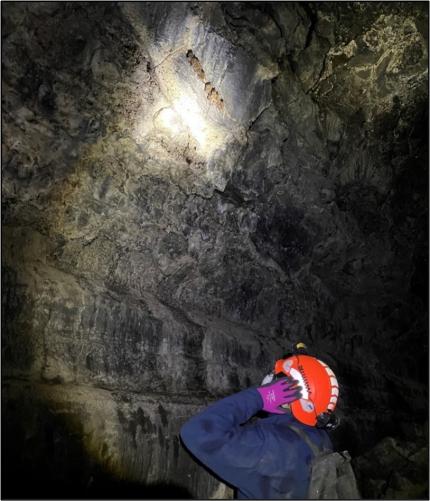
Dusky Canada Goose Surveys: Biologist Stephens and Holman continue to conduct dusky Canada goose surveys in Cowlitz and Wahkiakum Counties. The purpose of the surveys is to count dusky geese observed and read alphanumeric codes on any red collared geese. Wildlife managers survey the geese multiple times across their primary wintering grounds and use the data to generate survival estimates. The dusky geese are collared on their breeding grounds in Alaska every other year. Multiple species of Canada geese were located during the survey as well as Trumpeter and Tundra swans. Additionally, many wildlife species are incidentally encountered while conducting the goose surveys, especially in the relatively intact habitats of Wahkiakum County. These species included elk, Columbian white-tailed deer, black-tailed deer, many duck species, egrets and herons, bald eagles, and three species of marine mammals just to name a few.
Biologist Wickhem also continued dusky Canada goose surveys in Clark County, primarily on the Shillapoo Wildlife Area and around the Vancouver Lake Bottoms. On this survey, Wickhem recorded 161 dusky Canada geese including one with a red collar. Snow geese are still flocking in the thousands at Shillapoo, and there are still many ducks utilizing the wildlife area. Other species observed included northern harriers, red-tailed hawks, herons, egrets, sandhill cranes, and a juvenile bald eagle surrounded by white feathers feasting on a bird carcass.

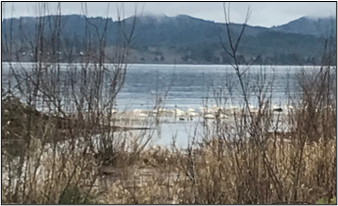
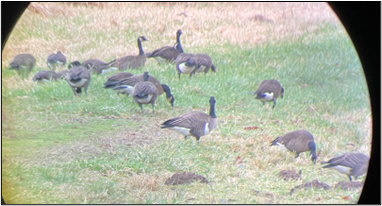

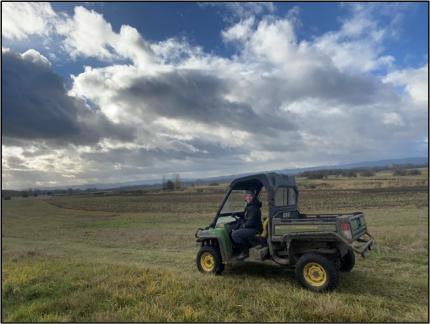
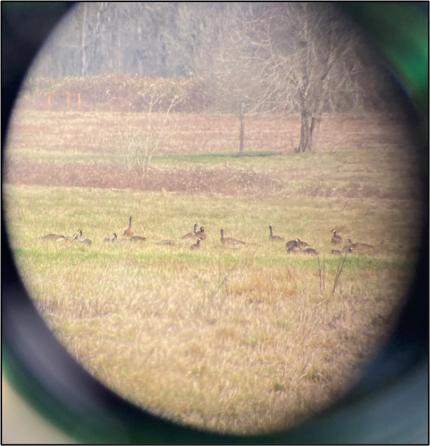
Klickitat Mule Deer Study: Wildlife Conflict Specialist Jacobsen and Volunteer Lieberg worked to put out a satellite GPS collar on a female mule deer in central Klickitat County. This collar is one of a larger dataset of satellite collars, roughly 80, tracking female mule deer over multiple years as part of a federally funded mule deer migration project in Game Management Units (GMU) 388 and 382.
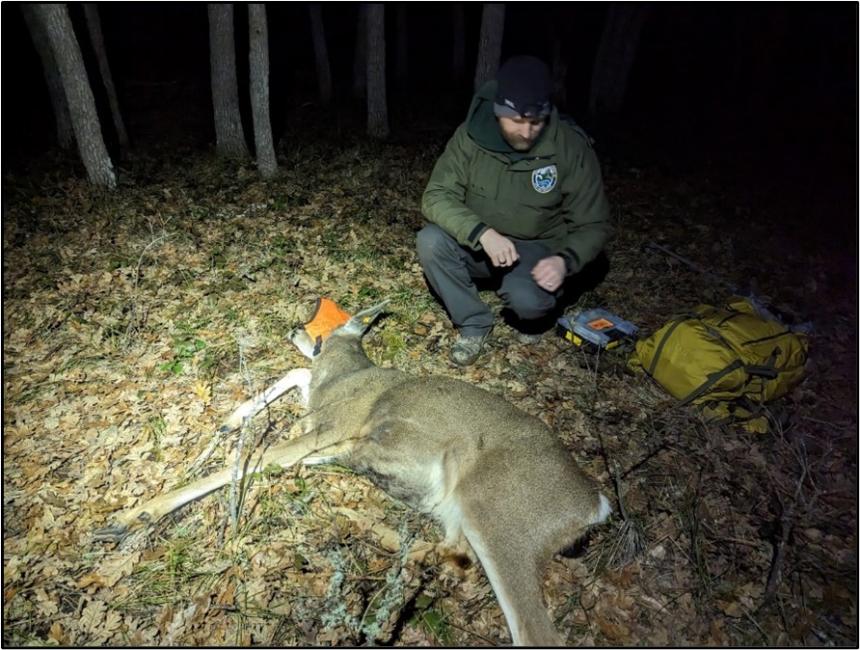
Treatment Turtle Transfer: Biologist Bergh picked up some of the northwestern pond turtles that had undergone treatment for shell disease at the Oregon Zoo and brought them to Cedar Creek Correctional Center near Olympia for their recovery. The turtles will be taken care of by three inmate technicians through the rest of the winter and released back into the wild this spring. This program is run by the Sustainability in Prisons Project out of The Evergreen State College and we are very grateful to the program and the technicians for their care of the turtles while they recover.
Mudflow Unit of the Mount Saint Helens Wildlife Area Elk Survey: Biologist Stephens and Customer Service Specialist Splitgerber conducted a survey of elk wintering on the mudflow in early February. They saw a total of 54 elk, which were classified as 30 bulls, 19 cows, and five calves. This survey is conducted twice a month between December and March.
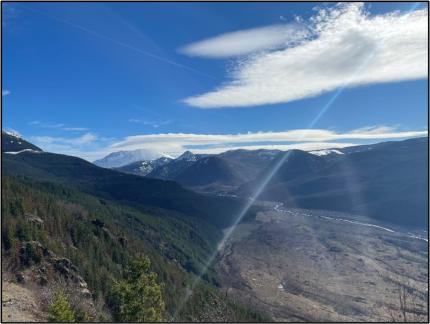
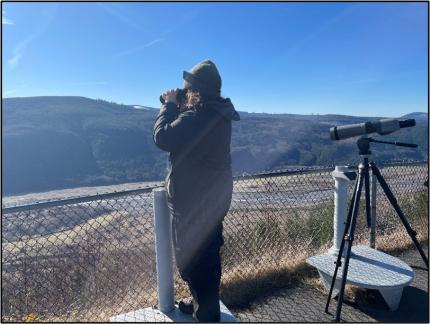
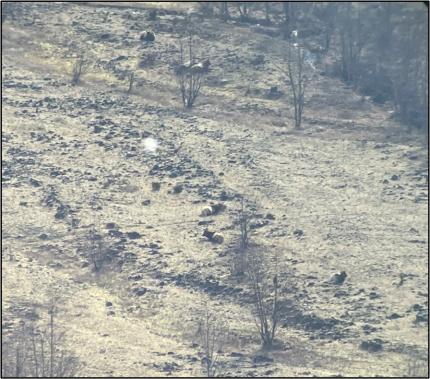
Providing Recreation Opportunities
Feline Hybrid: Wildlife Conflict Specialist Jacobsen responded to a media request regarding the mythical “Klickitat ape cat” that has been hotly debated by locals in the watering holes of Klickitat County. Jacobsen provided information on melanism in wildlife as well as on the biology of large cats of the world. Enough said on this nonsense.
Providing Recreation Opportunities
Abandoned Boat Removal: Private Lands Biologist Ferris was assisted by Private Lands Biologist Harris to retrieve an abandon boat dumped on an Access Program site in Wahkiakum County. Law enforcement investigation could not find a current registered owner. The boat had to be dragged several hundred feet to pavement where it could be placed on a flatbed trailer for removal. The Private Lands Access Program will fund the cost of this removal as a benefit of program enrollment.
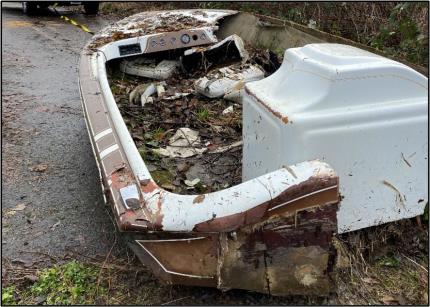
Providing Conflict Prevention and Education
Eagle Complaint: A concerned livestock producer contacted Wildlife Conflict Specialist Jacobsen to discuss options for eagle deterrents around his calving operations. The producer has had issues in the past with bald and golden eagles harassing, injuring, and killing newborn calves. Jacobsen suggested multiple different deterrent options to the livestock producer. Federal protections afforded to eagles substantially reduces the available options for livestock producers in these situations.
Elk Damage Hunt: Wildlife Conflict Specialist Jacobsen deployed a youth hunter from the Region 5 Elk Damage Pool to a property in GMU 574 that was incurring damage from elk. The elk were damaging a newly planted hay seeding. Due to the unseasonably low (or nonexistent) snowpack in the area, the fields were more susceptible to damage than normal at this time of year. The youth hunter was able to successfully harvest an elk with symptoms of hoof disease on the first day of his hunt. Hopefully this hazing activity will keep the rest of the elk at bay and out of the fields.
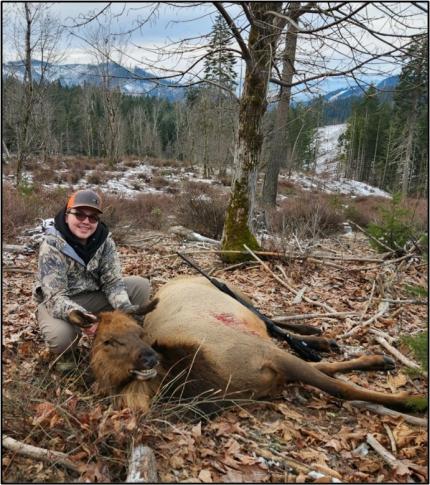
Elk Damage to Wheat: Wildlife Conflict Specialist Jacobsen met with a Klickitat County landowner in GMU 382 regarding elk damage to his winter wheat. The hoof compaction damage to the wheat from over 50 head of elk was substantial, and the grazing damage was moderate. Jacobsen deployed a youth hunter to the property, who successfully harvested a cow elk on the first morning of his hunt. Jacobsen will continue to work with the landowner to deploy damage pool hunters to the property. Jacobsen will also work with the landowner to utilize a drone in their upcoming elk hazing efforts. The elk have become accustomed to cracker shells, so novel techniques are necessary in this situation.
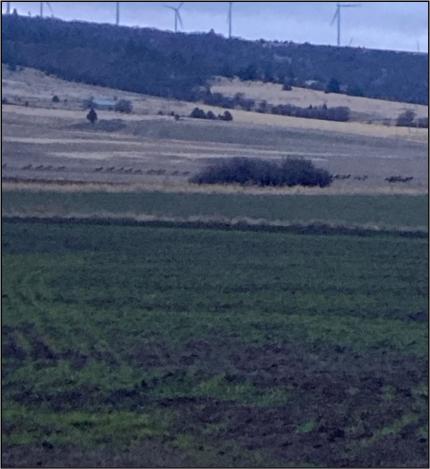
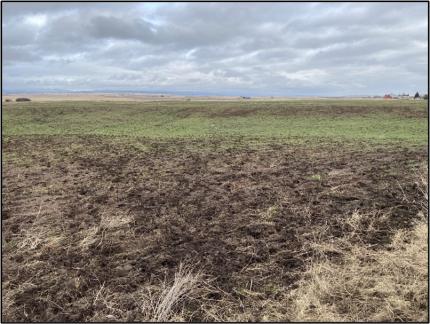

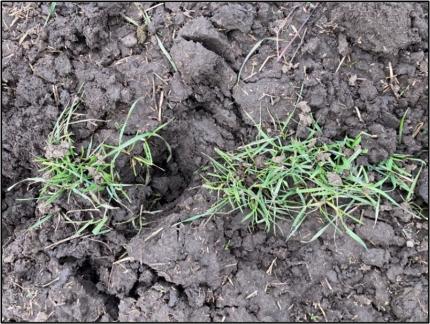
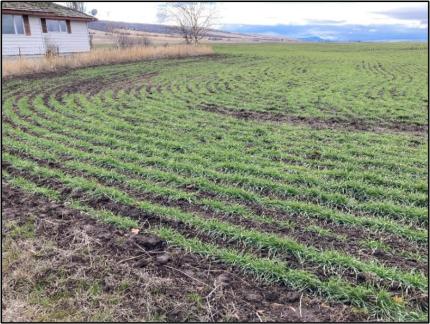
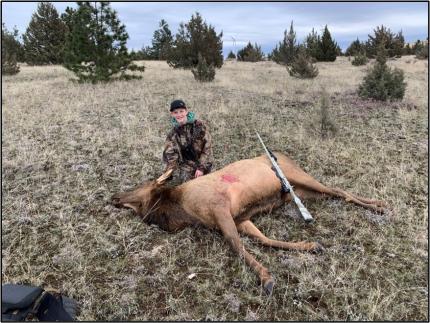
Conserving Natural Landscapes
Out with the Old: Over several days, Assistant Manager Breitenstein, Assistant Manager Risley, and Technician Fox worked on removing old fencing at Shillapoo Wildlife Area. The existing fence is over 25 years old and has seen a lot of use and abuse over the seasons. The primary purpose of this fence is to contain the cattle that graze the pasture during certain parts of the year and prevent the cattle from gaining access to oak trees that were some of the first trees planted at Shillapoo for habitat reclamation and enhancement. Over the course of the next several weeks, new fencing will be put up, free of holes and rotten posts.
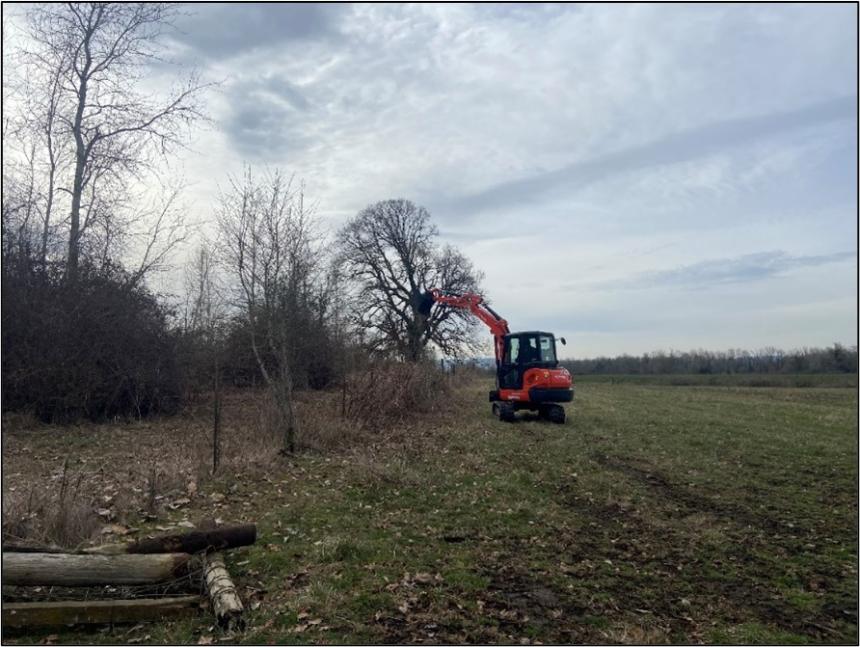
At the End of the Rainbow. Wildlife Area Manager Hauswald and Assistant Manager Risley surveyed for waterfowl at Shillapoo. These surveys are conducted twice weekly during the winter migration season to monitor habitat use by ducks, geese, swans, and sandhill cranes at the wildlife area. On this otherwise dreary day, a brightly colored rainbow made for some excellent photo opportunities.
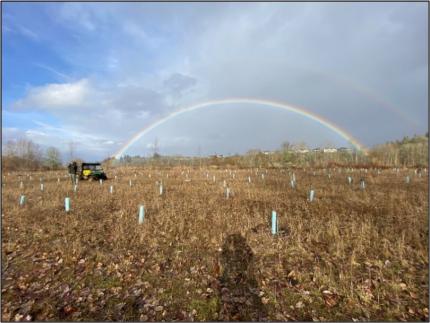
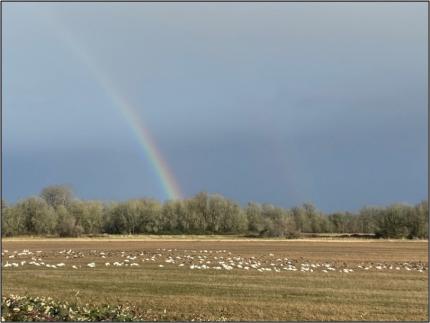
Looking for Signs of Life and Tracks: Wildlife Area Manager Hauswald and Assistant Manager Risley ventured up to the Mudflow Unit of the Mount St. Helens Wildlife Area to monitor survival rates of willow, wild strawberry, and big leafed lupine that were planted during spring 2022 for streambank stabilization along the Toutle River. Unfortunately, high water events over the past two months resulted in significant bank loss and much of the plantings were washed down river.
Fresh snow fall provided an opportunity to look for large predator tracks. Several coyote tracks were observed as well as a few bobcat tracks, but no large predator tracks were found. The Mudflow Unit is currently closed to the public and will remain so until May 1. This closure is to provide refuge and protection for the elk that over winter on the Mudflow. Wildlife area staff members do not visit the unit regularly during the closure, but when visiting the unit is necessary great efforts are made to avoid the elk so as not to cause stress to the animals.
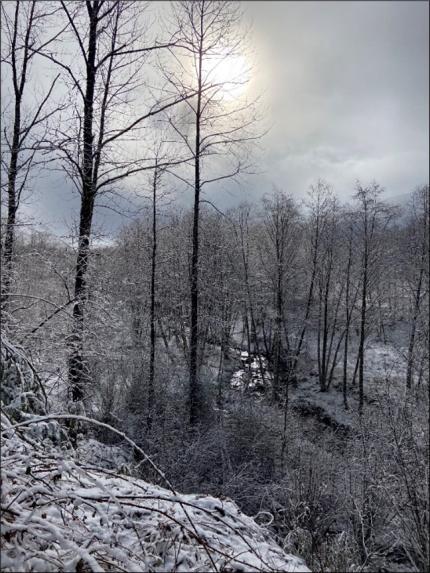
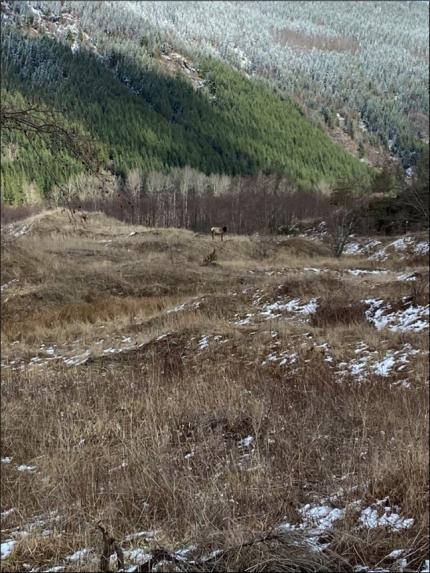
Managing Wildlife Populations
Puget Sound Ecosystem Monitoring Program Survey: Each year Biologists Evenson, Hamer, or Murphie conducts a survey of wintering waterfowl, marine birds, and marine mammals throughout the inland marine waters of Washington. Personnel fly more than 4,000 miles in December and January, and sometimes into February. Observers tally what they see, within a 50-meter strip on both sides of the aircraft, as they fly along 200 feet above the water at 85 knots (about 100mph). This survey has been completed for the season, data was transcribed, and submitted for analysis.
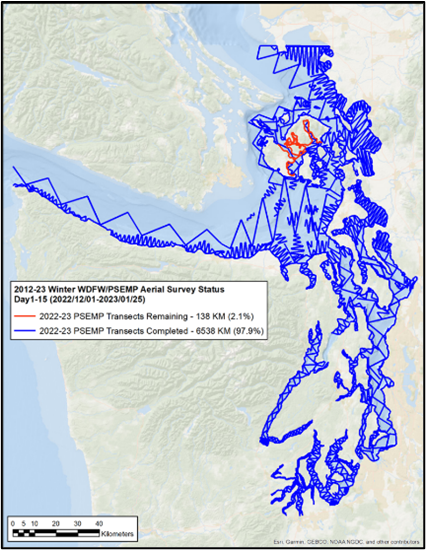
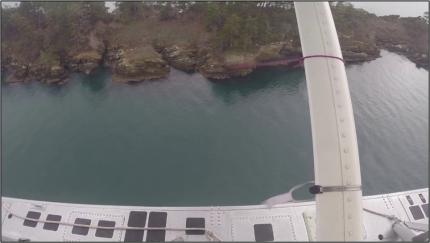
Providing Recreation Opportunities
Water Access Work: The Water Access team removed downed trees, cleaned storm damage, repaired fencing, performed preventative maintenance, and managed lots of vegetation at several access areas around the region.
Jefferson County, Tarboo Lake: As a result of attempted wood theft, two conifer trees were felled and left across the access site. In the process of wood poaching, the unknown party felled the trees, blocking their vehicle behind the trees. The vehicle was also stolen. They attempted to escape by cutting a section of fence for access but could not manage to get the truck out. The responsible parties left the trees, truck, and damaged fence. WDFW Enforcement assisted the vehicle owner with recovering the truck. Access staff members cut up trees, chipped the limbs, and repaired the fence in two places.
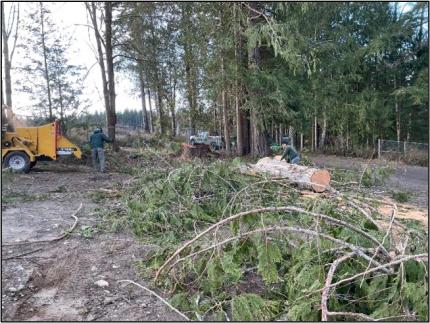

Thurston County, Hicks Lake: The access crew repaired nearly 75 feet of chain link fence that was damaged by fallen trees during a storm. This project was no small undertaking. Much of the damaged fence needed to be removed and posts straightened or replaced, including 60 plus feet of top rail. This also required a lot of groundwork to fit, stretch, and hang the chain-link at the appropriate height.
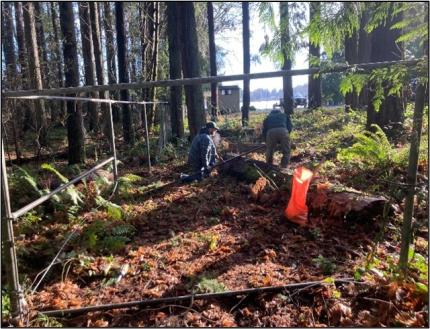
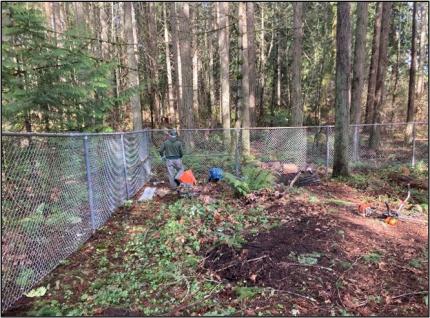
Mason County, Mission Lake: Access team with help from Washington Conservation Corps staff members and a local volunteer brushed out two long property boundaries and chipped all the debris at Mission Lake. In addition, they serviced the monofilament recycling bins in Mason County water access areas.
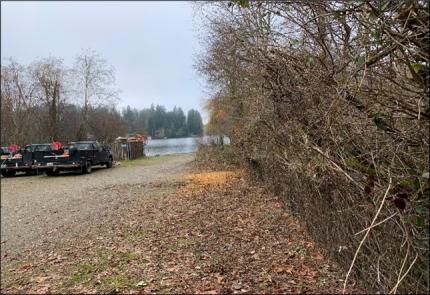
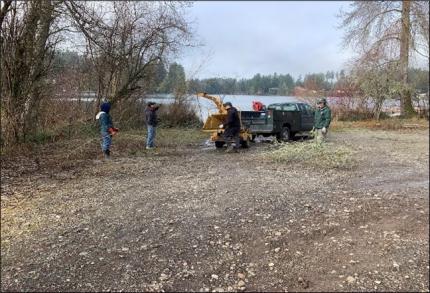
Conserving Natural Landscapes
North Olympic Wildlife Area: Wildlife Area Manager Laushman and Technician Morgan visited with the Clallam County Weed Board at units near Sequim to discuss noxious weed control in the area.
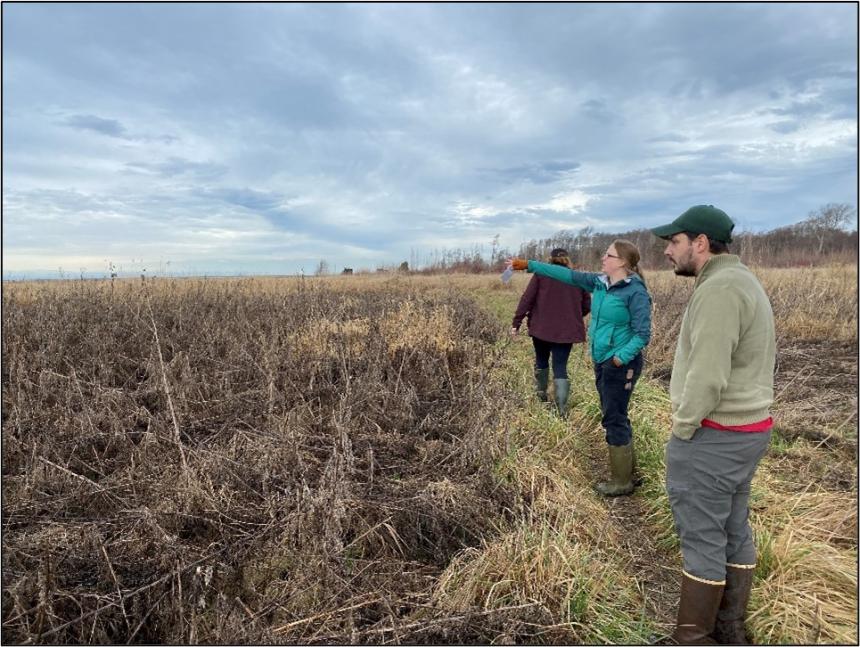
South Puget Sound Wildlife Area: Technician Morgan continued to chip away at populations of invasive blackberries around the Western Turtle Pond habitat and at scotch broom throughout the South Puget Sound Unit in Lakewood.
Providing Education and Outreach
General Wildlife Inquiries: Biologist Murphie responded to inquiries received by phone, email, or in person related to a deer, three osprey, and a sportsmen’s show.
Conducting Business Operations and Policy
Aircraft Safety Instructor Prep: We have two courses coming up in February. Aircraft Safety Instructor Murphie has been spending time on preparing the presentation for this course.